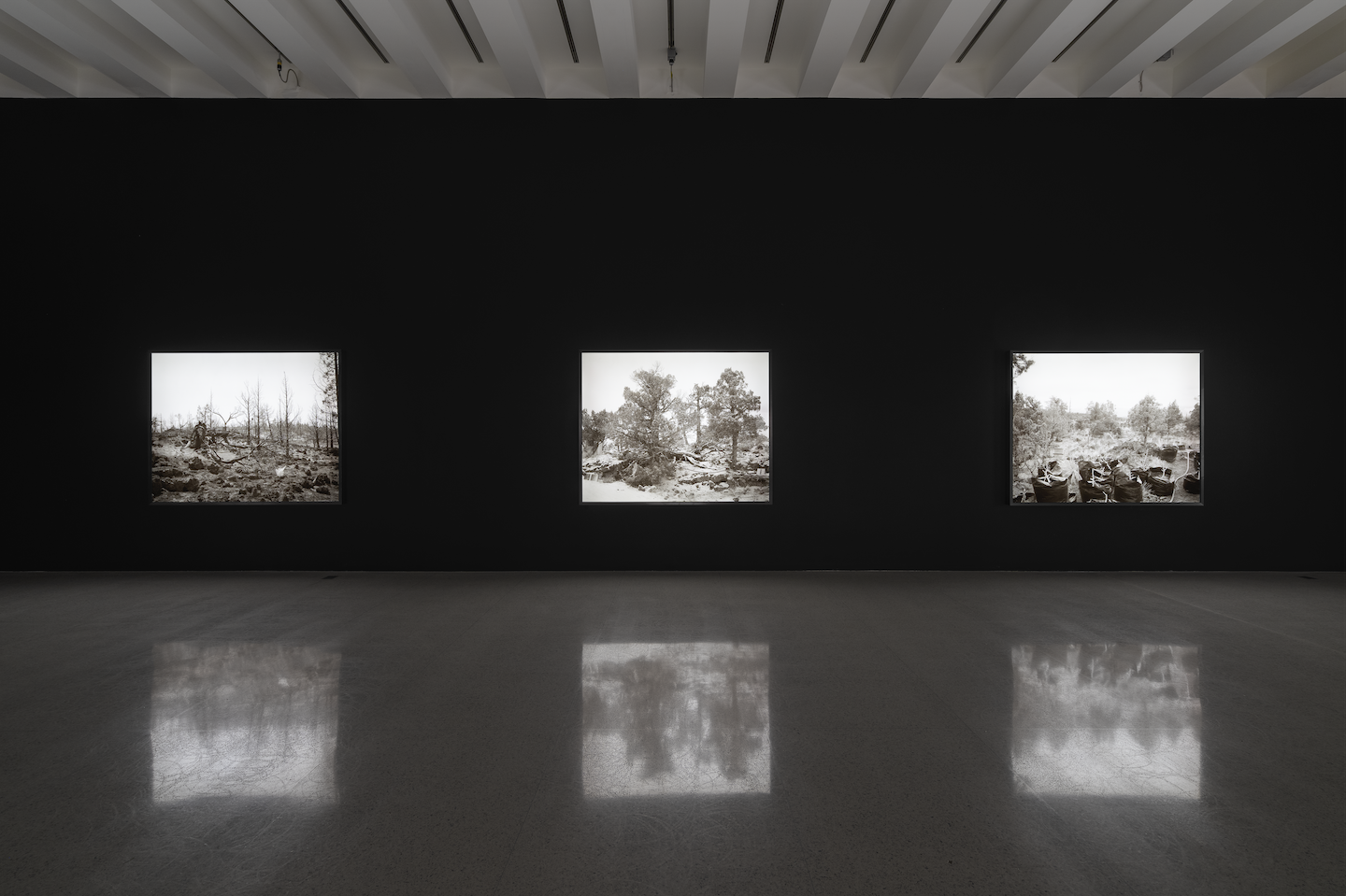I have a proclivity towards picturing imagery of a distinct tradition when prompted by motifs of the American West. Awe-inspiring, spatially generous works by Ansel Adams, Carlton Watkins, Timothy O’Sullivan, and other early landscape photographers flicker across the surface of my mind. Whether the portrayal was realistic or not, these works were meant to show the uncorrupted, yet-to-be industrialized grandeur of the Western landscape. Cascading waterfalls and seemingly endless snow-capped mountains offered up the suggestion of untapped possibility.
Representing the portrait photographer’s first venture into landscape, Pao Houa Her’s Paj qaum ntuj / Flowers of the Sky at the Walker Art Center offers a contemporary and culturally divergent expansion on this historic American genre. Her’s stills of the Mount Shasta region toy with dominating scale, black and white coloring, sharp focus, and occasional touches of ecological wonder to draw the viewer like a magpie; techniques akin to history’s classic images of the Western United States. The haunting magnetism of these landscapes is further enhanced by each work’s placement in a lightbox, inviting in a form of desire comparable to commercial enticement. Each view serves as its own source of illumination in the darkened exhibition space.
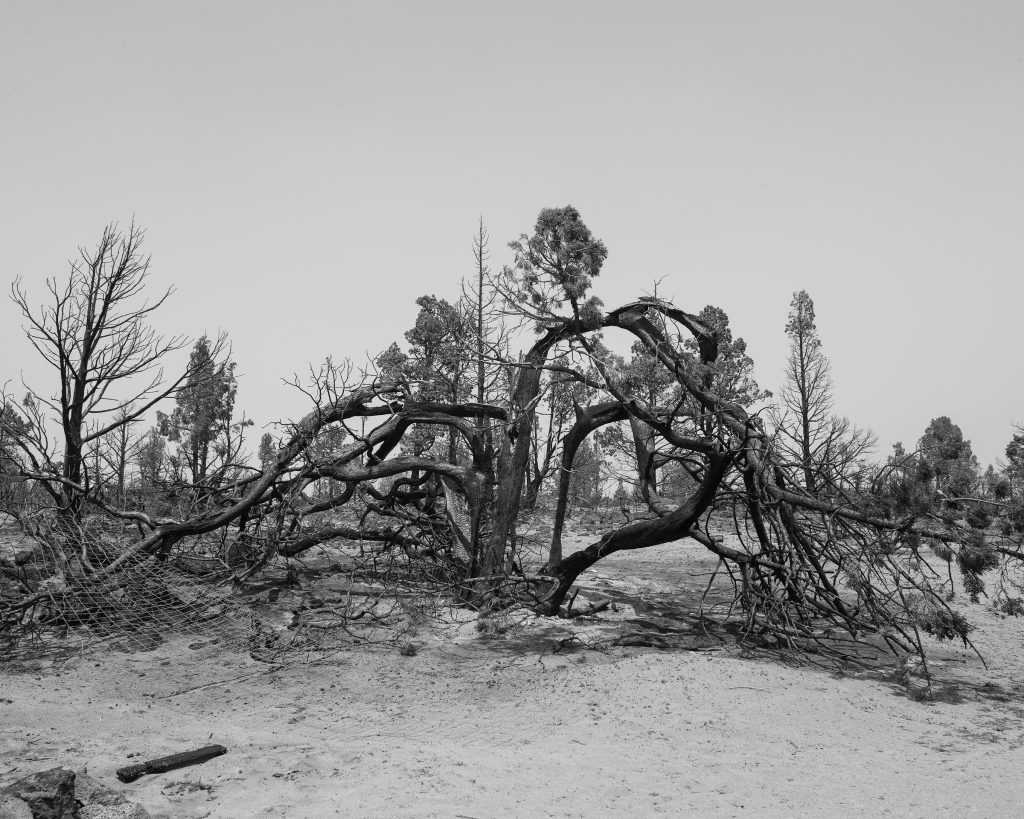
Her is Hmong American. She fled Laos with her family as a baby, crossing the Mekong River into Thailand on her mother’s back. One of the artist’s earliest memories is of portraits being taken of her family at a refugee camp. In a 2016 interview with Nathan RP Young for Hyperallergic, Her shared ruminations on this distant recollection:
“…thinking about it now, and looking at countless studio portraits, for a lot of us it’s a way out of reality, right?”
The bulk of Her’s practice has been in portraiture, ennobling family and members of the Twin Cities’ Hmong communities. Amongst the rotating works shown by Her in the most recent Whitney Biennial were two portrait photographs from her 2017 series After the Fall of Hmong Teb Chaw. The elderly Hmong women in these works are posed before densely-packed backdrops of mainly artificial foliage. White flowers hang from above and drape over large leaves and short palms. In one piece the woman gingerly fingers a variegated leaf, the edges appearing to fray ever so slightly, and gazes to the left of the camera.
The landscapes evoked through the staged flora and fauna in Her’s portraits are constructed via personal and collective memory. Her herself has little to no recollection of Laos. The mental image of her birthplace was assembled through familial stories and the tape-recorded Hmong folktales that put her to bed every night as a child. The migratory history of the Hmong people, in conjunction with the Hmong language’s solely oral past, has resulted in a culture grounded in storytelling. These ‘imagined landscapes’ create the backdrop for a number of her studio portraits and forge space for cultural identity from conglomerate memories.
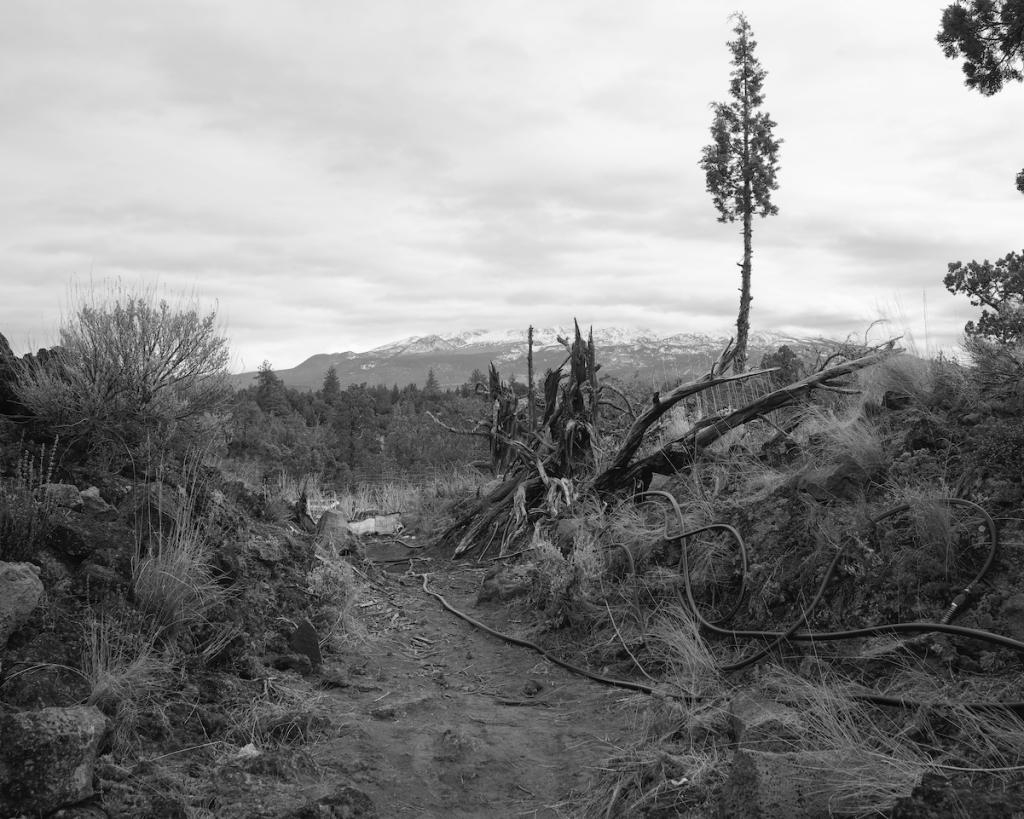
In the summer of 2020, Her traveled to the Mount Shasta region to visit family and was struck by the ways in which local Hmong communities created hospitable space amidst the dry volcanic land. Hmong roots in opium agriculture brought many to Northern California to cultivate marijuana following its legalization. ‘Paj qaum ntuj,’ as referenced in the exhibition’s title, translates to ‘flowers of the sky;’ a Hmong phrase referring to cannabis. This poetic title casts a somewhat prophetic haze over Her’s documentation of the remote landscape.
Two sets of vistas are conversing in Paj qaum ntuj / Flowers of the Sky: the lit stills of agrarian life in Shasta’s shadow and a set of smaller bird’s-eye images of the same region. In the large-scale landscapes fixed in lightboxes, massive trees split in the arid earth. Tall grasses spring forth from the spaces between volcanic rock and the occasional suggestions of past wildfire activate the looming stillness of the nearby volcano. Enveloped in the cool light radiating from these images, I was placed gently, but fully in their reality. The rural quiet becomes somehow audible and, despite the lack of bodily presence, portraits are embedded in these countryside stills.
Long rubber hoses twist down dirt paths and tangle in skirting bushes, a plastic bag clings to the tip of a slouching branch, sheets of hardware cloth shield bagged plants, a camper van sits nestled in the grasses. Human activity is everywhere in Her’s landscapes. Her images deviate from the inclinations of early American West photographers in suggesting the majesty of the seemingly untouched, and instead offer up a land laden with intervention. Within the landscape, a portrait of a people emerges.
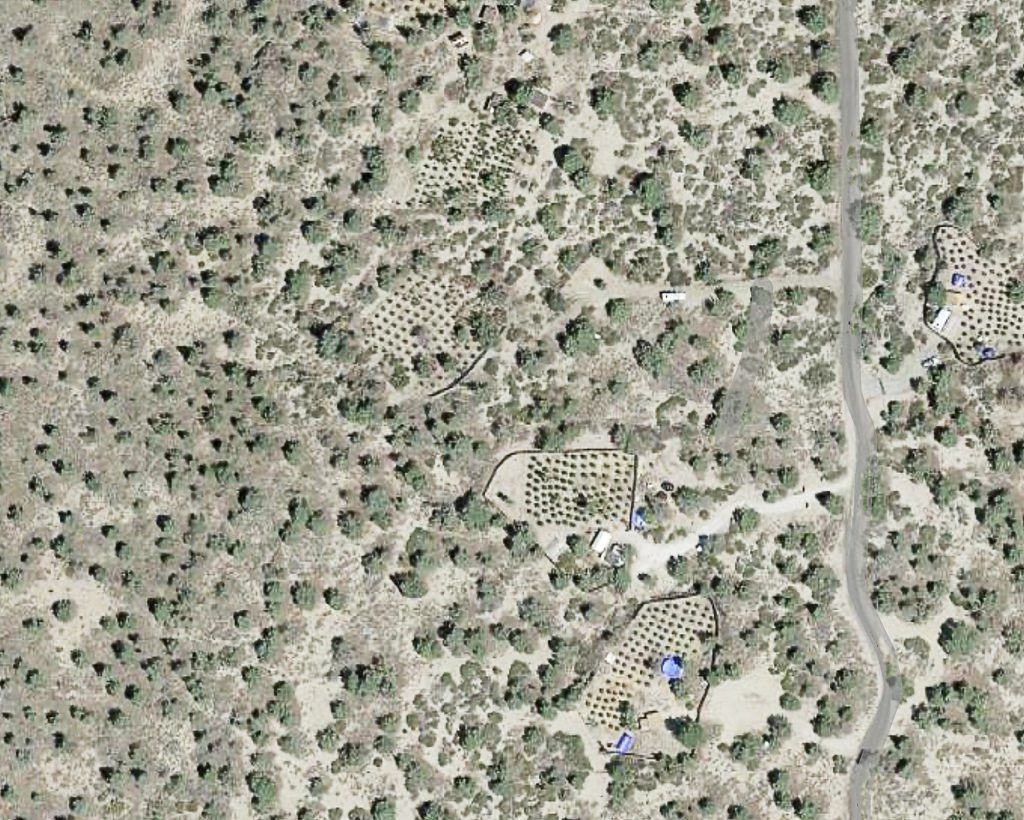
Her’s bird’s-eye views, taken on Google Earth, put forth summations of the many components at play in Hmong cultivation of this region. From above, the steep mountainsides flatten. The personified touches of human activity are vanquished. The landscape becomes a synopsis. The small fenced-in clusters of green dots are bespoke of the many cannabis farms that make up California’s emerald triangle—a term commonly used when referring to marijuana cultivation in this region. Her’s inclusion of these satellite images is a nod towards government surveillance of the region and the increasing number of permits required for marijuana farmers in California, placing strain upon the development of immigrant agricultural communities.
As stated previously, portraiture in its photographical form may not be present in Her’s Paj qaum ntuj / Flowers of the Sky, but as a theme, it is tacit in every work. The central source of animation in the exhibition is a two channel video and sound animation; the artist’s first exhibited foray into the arena of moving pictures. The video features a woman and a man, one in Minnesota and one in Laos, performing kwv-txhiaj (Hmong song poetry). The woman, filmed on her farmland in Northern Minnesota, sings about the war in Laos, her migration to the United States, and the prosperity she has enjoyed in this country. Despite this, her song continues into a contending yearning for Laos; for the landscape of her prior life. On the second screen, the man sings from a verdant Laotian jungle. He once lived in the US, but has since returned to his home country. He now pines for the abundance he once held on the opposite side of the Earth. The rhythmic waves of each voice saturates every crevice of the gallery. Even without lingual familiarity, the conflicted sense of longing, similar to a kind of homesickness, felt as though it permeated my core.
Expressions shift, figures sway, and the backdrops rustle with each passing breeze. Like Her’s landscapes, this video provides a living portrait of individuals intrinsically interwoven with land. The ‘imagined landscapes’ of her past works are substituted with the real and the present.
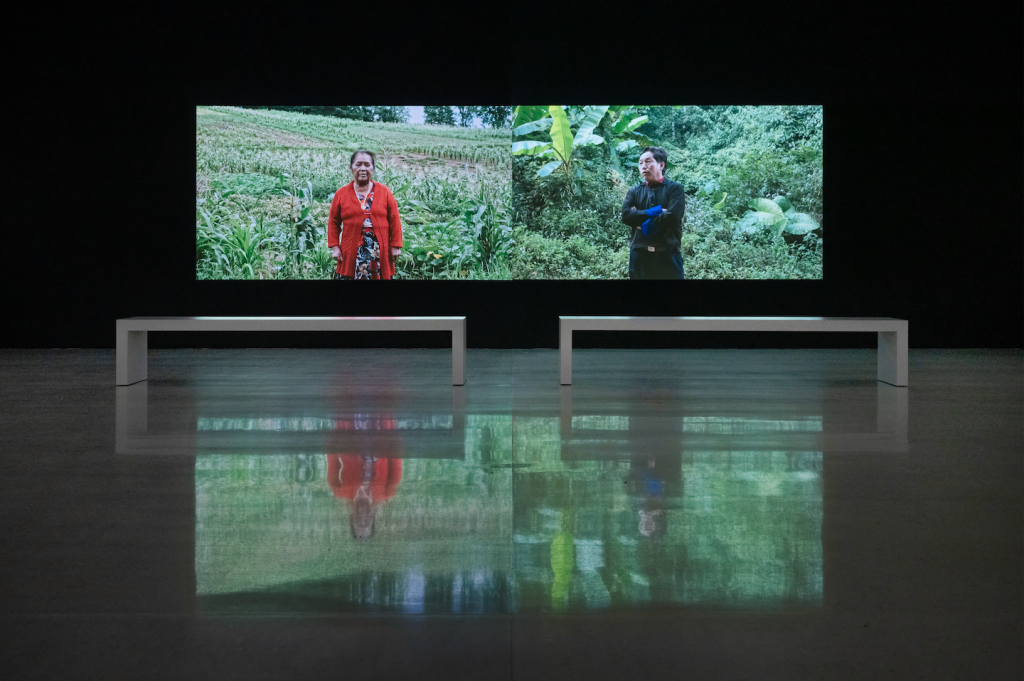
Be it through climate change or ecological circumstance, Mount Shasta has been irrevocably altered from the days of Adams’, Wadkins’, and O’Sullivan’s photographical wanderings. Paj qaum ntuj / Flowers of the Sky provides a contemporary take by offering a window into the lives of a people reestablishing cultural identities and histories via earthly intervention. The Hmong community settled on this land provide the mediation it requires and with that, continue to reestablish the rural lifestyles of their roots. A revistation to past prosperity in opium agriculture is allowed for and with it, a holistic cultural return. Through still and moving images, Her prods at the boundaries between landscape and portraiture, identity and place, human and earth. She lays out the joining of a past and a present—a place and a people.
Paj qaum ntuj / Flowers of the Sky closes January 22, 2023.
* * *
Sources:
- Her, Pao Houa. Sung, Victoria. Villar Miranda, Matthew. “Opening-Day Talk: Pao Houa Her: Paj qaum ntuj.” 28 July. 2022, Walker Art Center, Minneapolis, MN. Lecture.
- Fuller, Thomas. “California’s ‘Green Rush’ Takes Hmong Back to Their Opium-Growing Roots.” The New York Times, 3 June 2017, https://www.nytimes.com/2017/06/03/us/hmong-marijuana-california.html
- Young, Nathan RP. “The Flower-Filled Photos of Hmong Women on Dating Sites.” Hyperallergic, 26 July 2016, https://hyperallergic.com/313442/the-flower-filled-photos-of-hmong-women-on-dating-sites/
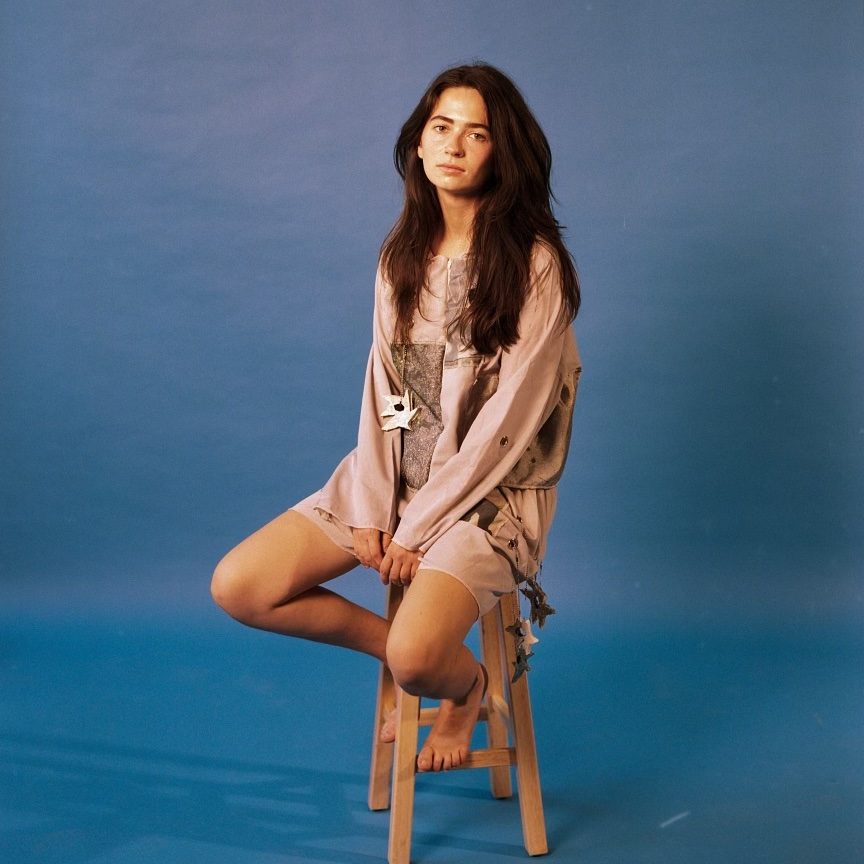
About the Author: Ruby Jeune Tresch (she/her) is currently based in Chicago, IL. Author photo courtesy of Lucinda Harstrick.
